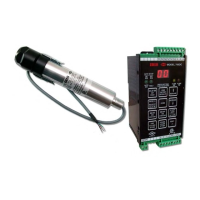IRIS MODEL 700/800 APPLICATION MANUAL
PAGE 6
is set to 31. To enable the Flame Relay to
energize, change this set point to a
reasonable value, or press LOAD FACTORY
DEFAULTS. If a Model 800 signal processor
is powered up with a different type of viewing
head, the green LED will blink rapidly. The
RESET button will clear the rapid blinking.
Connect a programmer or a computer and
change the RELAY ON SET POINT from 31 to
a reasonable value.
MODEL 700 POWER CONNECTIONS
The Model 700AC power and relay connections are
shown in Figure 2. The AC power supply in the Model
700AC Signal Processor is connected to input AC
power through a 2A fuse and an inrush current limiter.
Model 700DC power and relay connections are shown in
Figure 4. The nameplate current rating of 250mA maxi-
mum per signal processor with the viewing head plugged
in is conservative; there is no need to install more power
supply capacity than this.
In the Model 700 signal processors the flame relay (RF)
has two sets of FORM C (SPDT) contacts and the self-
check relay (SC) has one set (Figures 2 and 4). These
power contacts are all rated at 5A at 125 VAC, 277
VAC, or 30 VDC. The self-check relay is on whenever
the signal processor is on and is operating normally,
whether the flame relay is energized or not. It is not
necessary to wire the contacts of the self-check relay
in series with the contacts of the flame relay because
the actuating coil of the flame relay is wired in series
with other contacts of the self-check relay (not shown).
So the flame relay can only pull in if the self-check
relay already has.
In the Model 800 signal processor the flame relay has
two FORM A (SPST) contacts brought out to three ter-
minals and one FORM A (SPST) contact brought out
to two terminals (Figure 6). The flame relay is rated
5A at 125 VAC, 277 VAC or 30 VDC. The Self-Check-
ing relay has one set of FORM A (SPST-NO) contacts
rated .4A at 110 VDC or 125 VAC and 2A at 30 VDC.
In all Model 700 and 800 signal processors, special
fail-safe circuitry is used to drive the coils of the self-
check relay and the flame relay. This circuitry is de-
signed so that any component failure will cause the
flame relay to open. Also note that if the processor
output which drives this circuitry sticks high or low, both
relays will open.
Some of the internal power wiring of the Model 700AC
and Model 700DC signal processors is shown in Fig-
ures 2 and 4. Rectifier diodes separate the battery backup
input from the main power bus until the battery voltage
exceeds the internal DC voltage plus a diode voltage
drop. Resettable fuses (shown as resistors with slashes)
and conventional fuses prevent internal failures from
loading the power sources. With the Model 700DC, if a
backup battery is to be used with a main power supply,
the two power sources would be wired as shown in
Figure 4. If no backup battery is to be installed, the
main power supply can be connected at +26V PWR
and GND as shown in Figure 4, or it can be connected
to the +24V BATT input and GND. It is preferable, in
fact, to use the battery connections because this takes
advantage of the resettable fuse at the battery input.
(Resettable fuses recover automatically from a fault
within a few seconds after power is removed.) At the
+26V PWR input and its associated GND, conventional
1A fuses are used because they are able to protect
against 240VAC being applied by accident (this could
happen if a Model 700DC is installed in a cabinet wired
for a Model 700AC).
VIEWING HEAD CONNECTOR AND WIRING
Connectors and cables are shown in Figures 9 through
12. The molded connector, cable, and adapter shown in
Figures 9 and 10 have been discontinued in favor of a
cable with a shield. (They are shown for reference
only.) Figure 11 shows the viewing head cable with the
½” NPT pipe fitting for use in a conduit. This gray
cable is labeled: LAPP USA UNITRONIC 190CY
B (UL) TYPE CMG 105C 22AWG/4C SHIELDED
E130334 –- CSA CMG 105C or AWM II A/B 300V
LL74246. The standard pigtail length is 20", but it can
be supplied in longer lengths if requested. This same
gray cable is shown in Figure 12 for regular viewing
head service. Because it must be used with a conduit
in hazardous locations, it is not normally supplied except
when requested. It may be ordered commercially as
Olflex 602204S.
The recommended cable for hazardous locations, C-
330, is shown in the lower part of Figure 12 with the
right-angle connector. It is supplied as standard in a 15
ft. length. This cable does not have to be used in a
conduit. It is labeled: IRIS SYSTEMS INC. C-330
E193849 (UL) TYPE ITC 4/C 18 AWG 90C 300V
OR c(UL) CIC 90C 600V FT4 SUNLIGHT
RESISTANT. If a cable longer than 15 ft. is needed,

